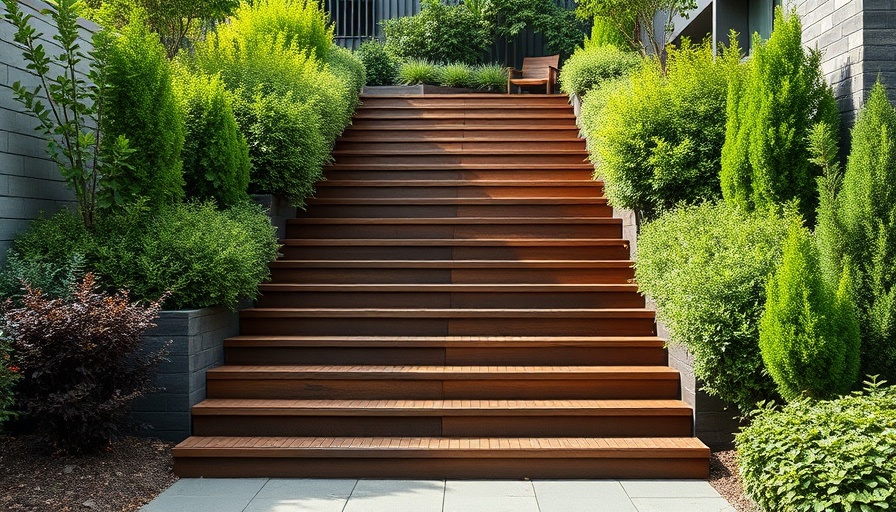
Transform Your Landscape with Smart Garden Stairs
Integrating garden stairs into your outdoor design is not just about accessibility; it’s about creating a striking focal point that enhances both aesthetics and functionality in your yard. As homeowners increasingly appreciate the beauty and practicality of layered landscapes, these thoughtful details become an essential part of yard renovations. Let’s explore several inspiring ideas to elevate your landscaping with garden stairs.
Natural Stone: A Rustic Touch
One of the best materials for garden stairs is natural stone, known for its earthy charm and timeless appeal. Options like flagstone, fieldstone, and limestone not only withstand the elements but also blend beautifully with the natural landscape. To incorporate stone steps into your garden, consider the following tips:
- Choose flat, large stones: Ensure stability and a cohesive look.
- Dry-stack for a rustic feel: This method enhances the organic appearance of the steps.
- Maintain proper drainage: Tilt each stone slightly to prevent water pooling.
- Use gravel underneath: This will help with stability and prevent shifting.
- Incorporate greenery: Add moss or creeping plants between stones for added softness.
When selecting stones, match or complement existing natural elements in your landscape for a seamless integration that feels like a natural part of your garden.
Wooden Steps: Warmth and Timelessness
Wooden garden steps offer a classic choice for those seeking a warm and inviting aesthetic. Their organic textures and rich tones contrast beautifully with vibrant foliage, creating a cozy transition between levels. Here are several practical tips to design wooden stairs effectively:
- Choose durable wood types: Options like cedar or redwood withstand weathering while providing beautiful colors.
- Consider decorative railings: They add charm and increase safety, particularly in sloped areas.
- Finish with non-slip treatments: This ensures safety during wet conditions, making your stairs functional and beautiful.
- Emphasize the surrounding landscape: Use complementary plants and lighting to enhance the inviting nature of wooden steps.
This rustic warmth can transform any backyard design, elevating your space and inviting guests to explore beautifully crafted terraces.
Concrete Steps: Modern and Versatile
Concrete steps deliver a modern, customizable solution for homeowners. Unlike wood or stone, concrete can adapt to numerous styles, whether you're looking for a sleek, contemporary look or a more rustic aesthetic.
- Use decorative stamps or colors: This allows you to personalize your concrete steps to fit your landscape theme.
- Shape flexibility: Create different shapes and sizes to fit your property layout, from straight lines to curves.
- Ensure drainage: Similar to natural stone, proper tilting ensures lasting performance and prevents pooling.
For an extra flair, consider framing your concrete steps with decorative gravel or low-growing shrubs that highlight your entryways.
Future Trends in Garden Design: Sustainability and Functionality
As environmental consciousness increases, future garden designs are expected to prioritize sustainability. Homeowners are now incorporating eco-friendly materials and integrating native plantings that require fewer resources. Curved and layered steps can help manage rainwater runoff effectively, thereby benefiting local ecosystems. This trend also harmonizes with the broader movement towards sustainable living, which resonates particularly with younger homeowners seeking to make greener choices.
Actionable Insights to Inspire Your Next Project
It’s essential to think not just about the aesthetic impact of garden stairs but also their integration into overall landscape design. Understanding how each element works together can enhance your garden’s functionality. Get inspired by local landscapes, consider visiting nearby gardens, or consult with a landscape designer to bring these ideas to life.
Add Beauty and Function Together: Final Thoughts
The inclusion of thoughtfully designed garden stairs can take your outdoor space from mundane to extraordinary. Whether choosing natural stone, warm wood, or modern concrete, the key is to make selections that resonate with your personal style and the overall vision for your landscape. Don’t hesitate to mix materials for a unique look! Transform your yard into a beautiful layered masterpiece that invites exploration and enjoyment.
If you’re ready to enhance your outdoor space and learn more about the possibilities that garden stairs can offer, reach out to local landscaping experts for personalized insights and assistance.
 Add Row
Add Row  Add
Add 




Write A Comment